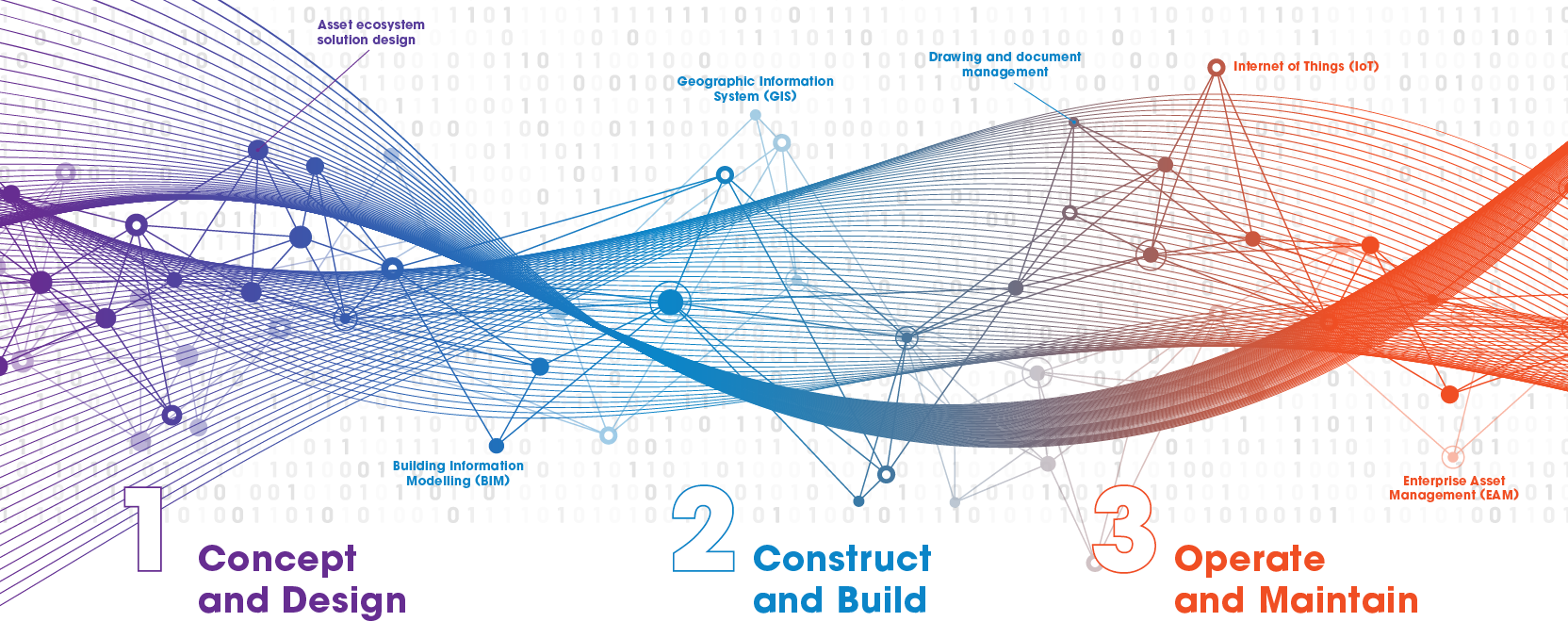At a glance
- Enterprise asset management as a concept is really the ability to access and use the right pieces of information from multiple systems, making fast access to good data more important than ever.
- Organisations that have mastered asset information integration often see GIS emerge as a critical central point of entry to information from other corporate systems.
- There is rarely a plug-and-play solution to connecting corporate systems without introducing a whole new set of challenges, making planning, preparation and careful execution critical.
Having incorrect or outdated information can cost a utility or infrastructure-orientated organisation dearly in terms of lost time, wasted resources, damage to property, injury or worse. Imagine if your Dial-Before-You-Dig report was incorrect before you broke ground!
Managers and Engineers rely on having access to the most current information to co-ordinate teams and allocate machinery or other resources to time-critical jobs. Bottlenecks or delays in real-time information transfer between key corporate systems can result in different systems reporting different information about the same incident. This happens all too frequently when data is required across multiple systems and snapshot copies of data are transferred periodically between systems. The result is that the systems are almost always out of sync and the lack of up-to-date information can result in a small, preventable issue rapidly escalating to become a big problem.
Breaking down data silos
Historically, deciphering the location of an asset or maintenance event in an Asset Management System felt a little like trying to solve a Story Sum for a Maths exam at school. You remember the kind of thing: “the faulty valve MWVALVE1234 is located on the kerb outside 13 High Street which connects to water main WMAIN7654 that runs down the south side of High Street…”.
In the mid-1990’s Geographic Information Systems (GIS) reduced this complexity by allowing assets and maintenance requests to be mapped and overlaid with an unlimited number of complimentary mapping layers such as street names, property boundaries and aerial photography. This meant that maintenance event and asset data could be recorded and managed within the Asset Management System, while location information could be managed exclusively within the GIS. Maintenance crews were finally able to plan routes between jobs that reduced travel times and improved service response times.
As information technologies and enterprise asset management systems (EAMS) continued to evolve, many enterprises found themselves with a wealth of descriptive information about assets - costs, location, performance - residing in different systems and, sometimes, that data was in conflict. The extent to which this information remains locked in the silos of disparate information systems, rather than accurately and reliably available when and where it's needed, relies on effective integration.
Enterprise asset management as a concept is really the ability to access and use the right pieces of information (and that information needs to be descriptively and temporally accurate and authoritative) from enterprise IT systems. Organisations that have mastered asset information integration often see GIS emerge as a critical central point of entry to information from other corporate systems - financial data from the ERP, As-Built drawings from the corporate document system, or monitoring data from SCADA - accessed by clicking on a map.
How to integrate asset information
It has been COSOL's experience that enterprise asset management is only achievable when multiple systems are properly integrated, creating an asset information ecosystem. In this way, data is collected, stored and maintained in the application best suited to individual enterprise asset management functions across the asset lifecycle. An integrated information ecosystem accesses the best data from each system to present a collective and actionable description of an asset, how it affects others related things (customers, service levels, other assets in the network), its condition, maintenance history, cost to build, cost to maintain, and so forth.
However, there is rarely a plug and play solution to connecting corporate systems without introducing a whole new set of challenges - such as incomplete or inaccurate data, slow system performance or duplicated data sets. Here's our three-step approach to delivering robust asset information integration:
1. Mapping the asset information ecosystem: understanding your data and systems
Some combination of ERP, EAMS, document management, and GIS software applications is likely to be found in most asset-intensive operations. The key to a successful asset information ecosystem is having clear processes and ownership rules for the data flowing between them. A task complicated by the fact that individual data points, and the applications in which they are maintained, may change over the course of the asset lifecycle.
Designing asset information integration therefore goes beyond identifying the various software packages in play and finding the APIs that connect them. COSOL has helped clients unravel the "spaghetti soup" architecture that results from this approach, where huge numbers of interfaces add to support overheads and limit the ability to apply new software upgrades. Rather, mapping the data attributes you need to collect to support business processes and the applications best suited to managing that data across the asset lifecycle is the best place to start. It may seem to be a matter of simply storing the mapped object (a point, a line or a polygon) and its unique Asset Identifier in the GIS and everything else relating to the asset (including its GIS identifier) in the EAMS. In reality, this seldom works. For example, a linear asset has length and a polygon has an area and these are best stored within the GIS so that edits can easily be tracked. Considering that there is a lot of attribute data, documents and media associated with assets, along with comprehensive maintenance and inspection history, careful planning is required to ensure that the replication of data between systems is seamless and meets business objectives.

2. Preparing the site: integration planning to good practice principles
Before building connections the business rules for integration need to be established, and there are a number of best practice principles that can be applied. Which data is required in real-time versus updates that can be processed outside peak operating hours? How often is a full sync required versus only the data points that have changed since the last update? Defining a Common Data Model provides a single, shared language for the way assets will be classified, named, related to each other and the attributes to be recorded across the full range of asset management processes and systems.
Like the preparation that goes into painting your home: the time you spend scrubbing with sugar soap and masking up the window frames may feel like it's just delaying you from getting on with the rewarding part of seeing your new colour scheme come to life, but the effort will be worth it in the end.
3. Executing the Change: Technical approaches to Maximo/Esri Integration
With the preparation complete comes the final step of building the connections between systems and there may be a variety of methods for achieving this according to the applications you're using. Some software vendors may offer 'embedded' integration capabilities that are little more than import/export functions. This manual process requires human intervention and is fraught with potential glitches during processing. Other options include presentation level integration, where data points from various sources are passed through a user interface such as a web-page URL; workflow driven processes, where actions in one system are triggered by an event in another system; or full communications-level integrations using third-party middleware to facilitate data transformation.
Integrating GIS data across the asset information ecosystem introduces a new level of complexity and care should be taken to align each of these three steps with the desired business outcome. We'll explore each of these steps in further detail in future posts.
Look for some examples of GIS/EAM integration in action in the videos in our Mapping & Visualisation showcase.
Why GIS integration matters
The benefits of breaking down technical and cultural information silos through integration are widely known and understood. Building an integrated asset information ecosystem around GIS offers far more than a solution to inefficient work, duplicated data, and a fragmented view of the customer. Consider the potential when location data is core to asset management functions:
|
GIS/EAM Platform Capability |
Benefit |
|---|---|
| Track all infrastructure assets | The GIS is a system of record for all of your infrastructure assets. Users can search for specific assets to add or edit details. |
| Generate work orders | When coupled with a GIS, work orders created in a CMMS or EAM system can automatically fill in the location data for workers so that every job is performed in the correct location. |
| Improve routing of workers | When dispatching technicians for emergency work, it’s important they get to the job site quickly. Many GIS vendors offer functionality to help determine the quickest route for fleet vehicles. |
| Real-time, shared web map | Workers in the field can use mobile devices or laptops to view a web map to confirm they’re at the correct location or look up details about infrastructure before starting. Offline maps enable users to access information without a connection, and automatically sync updates when the connection returns. |
| Analysis and reporting | Create custom reports within the GIS or the CMMS/EAM to identify which types of pipes break most often, which areas of the city generate the most work orders and more. |
Moving forward
When there are so many options to choose from and so much to be done, it's not surprising that resources become stretched and frustrations rise. Motivation levels can plummet as projects are adopted that don't appear to address the problems they were intended to solve, and achievements seem to pale in comparison to other organisations.
All of these GIS integration pitfalls not only exist, they are prolific and they are absolutely avoidable, or at the very least can be effectively managed with the right game plan.
Psychologists tell us that we make most decisions (and purchases) based on emotion rather than logic. Every decision we make is usually the best decision at the time, considering the information that was available to us at that point. When we are presented with alternatives through new technologies or simply seeing what others are doing, we may feel like we are falling behind in the adapt-or-die asset management landscape. It can sometimes feel daunting to try and unravel the complexities around getting the right balance between GIS, Asset Management, ERP and other corporate systems. Everything seems to impact on something else and changing one activity can very easily derail another.
When we’re bearing down on what seems like an endless task with so many options, it is comforting to know that support is available. Clarita Solutions works with many leading utility and infrastructure custodians to provide impartial, industry-best-practice strategic advice. We form life-long partnerships with our customers that is based on a win-win philosophy, always. Our team of experts are here to help navigate a clear direction through the stormy seas of integration.

